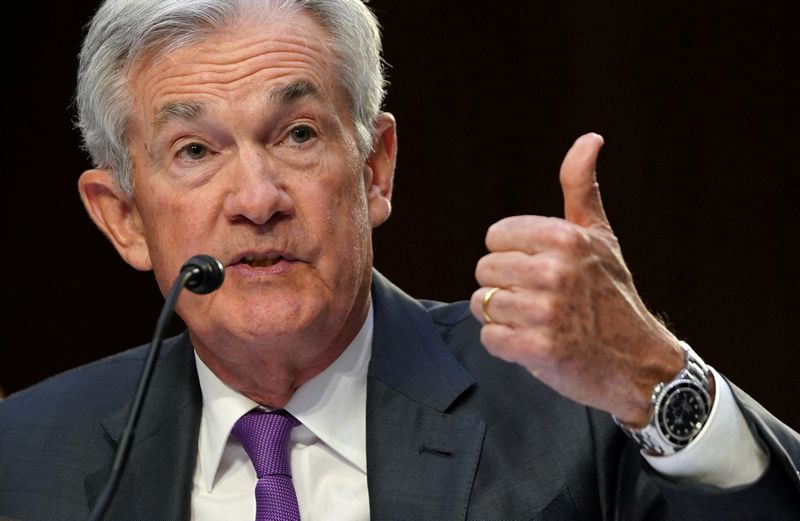A look at the day ahead in U.S. and global markets from Mike Dolan
It's hard to overstate the market impact of Tuesday's hawkish congressional testimony from Federal Reserve Chair Jerome Powell - and if he didn't intend that to happen, he's got one more chance to calm the horses.
In what appeared like an admission of a Fed error in misreading the strength of the economy and slowing the pace of interest rate hikes too soon, Powell told the Senate banking committee peak rates may have to be higher than thought and the central bank may have to move in larger clips yet again.
Rate markets are still scrambling to re-set and even the White House seemed taken aback by what it hoped would not be an overreaction to the surprisingly robust start to the new year.
"The White House isn't going to interfere with the Fed's management," an official said. "But we're dealing with one month of data and people need to sit back and take a breath."
Even though Powell reprises the testimony and Q&A session to the House on Wednesday - an opportunity Fed chairs have sometimes used in the past to lean back against excessive market reactions - investors didn't seem inclined to take deep breaths or wait for fresh nuance.
Although split early on Tuesday about the size of the next rate hike this month, futures market now assumes an 80% chance the Fed will return to half-point rate rises and bring its policy rate target range to 5.0-5.25% later in March.
The market's implied terminal rate has moved to 5.65% sometime between July and September - some 70 basis points above what was assumed as recently as Feb. 1. And two-year Treasury yields topped 5% for the first time in 15 years.
Asset managers such as BlackRock (NYSE:BLK) now see a reasonable chance Fed rates could hit the 6% mark that many thought fanciful only a couple of months ago.
The frenetic activity saw the measure of implied Treasury market volatility jump to its highest level this year.
But the aggressive Fed stance appears to be finally gaining traction on longer-term market expectations that finally see some impact on nagging inflation at the cost of causing a bigger drag on the economy, possibly to the point of recession.
Two-year 'breakeven' inflation expectations in the bond market fell back below 3% following a jump of a full percentage point in just six weeks.
And while 2-year yields raced higher, 10-year Treasury equivalents barely budged ahead of Wednesday's latest auction. That means the 2-10 year yield curve inversion - often seen as a harbinger of recession - deepened to more than 100 bps for the first time in 41 years.
Against that backdrop, the relative resilience of the stock market remains impressive. Although Wall St benchmarks lost more than 1% each on Tuesday, world stocks were more contained, and U.S. futures held steady.
With many analysts concerned that overseas central banks may not want or be able to keep pace with another leg higher in Fed rates - as so often in previous tightening cycles - the dollar was one of the biggest winners from Powell's jolt.
The DXY dollar index hit its highest level since early December last year. Sterling, the Japanese yen, China's yuan and both the Australian and Canadian dollars all hit their lowest levels of 2023.
The Australian dollar took an outside hit as the Powell testimony came the same day as the Reserve Bank of Australia signalled it may soon pause its rate rise campaign. And the Bank of Canada is expected to confirm on Wednesday its previously flagged intention to do likewise.
While Powell said he thought the Fed's 2% inflation target could still be met without dealing a major blow to the U.S. labor market, he acknowledged on Tuesday that "there will very likely be some softening in labor market conditions."
Powell's stance on the tight labor market will get a reality check on Wednesday from January JOLTS data on job openings, as well as the readout from ADP (NASDAQ:ADP) on private sector payrolls in February - all ahead of Friday's nationwide employment report for last month.
If January's economic "boomlet" was just a blip, as some in the Fed and elsewhere still have an open mind about, then these updates should reveal it.
Key developments that may provide direction to U.S. markets later on Wednesday:
* U.S. Feb ADP private sector payrolls report, Jan U.S. trade balance, JOLTS job openings report.
* Bank of Canada policy decision
* U.S. Federal Reserve Chair Jerome Powell testifies to House Financial Services Committee. Richmond Fed President Thomas Barkin speaks. Fed releases 'Beige Book' of current economic conditions
* U.S. Treasury auctions 10-year notes
* U.S. corporate earnings: Campbell Soup, Brown-Forman
Graphic: U.S. yield curve inversion biggest in 41 years https://fingfx.thomsonreuters.com/gfx/mkt/znvnbxogavl/One.PNG
Graphic: Odds surge for larger Fed rate hike in March https://www.reuters.com/graphics/USA-RATES/FEDWATCH/egpbyowyqvq/chart.png

Graphic: Fed rates and US core inflation https://www.reuters.com/graphics/USA-FED/INFLATION/gkvlgnaywpb/chart.png
Graphic: U.S. payroll growth remains strong https://www.reuters.com/graphics/USA-FED/JOBS/byvrjgewnve/chart.png
(By Mike Dolan, editing by Tomasz Janowski mike.dolan@thomsonreuters.com. Twitter: @reutersMikeD)